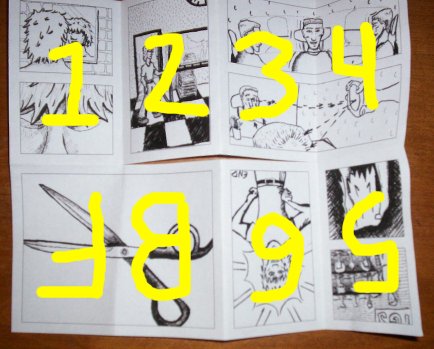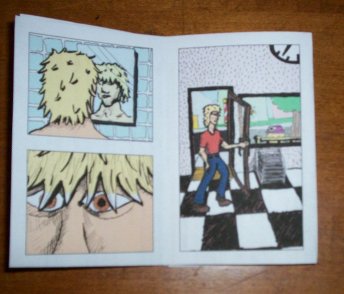

A couple days ago I picked up some new pens, and I wanted to try out some different workflows for doing comics without committing myself to any big projects. So I remembered this way of using one sheet of paper, making one cut, and folding it up into a booklet of six pages, plus front and back covers, no binding required. I found some instructions showing how it works, and then this is essentially a 16-page version of the same thing.
We made dozens of these stupid things when I was little. All the printing goes on one side of the initial paper sheet, so it's a good use of scrap paper that's only been used on one side. And the cut you make is centered in the page, so you could even do a booklet that unfolds and folds back into a second booklet (ideas: a Transformers story that recounts one (short!) battle, once from an Autobot point-of-view and once from a Decepticon, and literally "transforms" between the two; a book of (a few!) puzzles that unfolds into an answer key; rock-and-roll lyrics concealed inside an innocent (much abbreviated!) Chick tract).

Starting with an 8.5" x 11" sheet of paper means each page is 2.75" x 4.25", which is really only divisible into two panels, which presents a challenge as far as narrative is concerned. I didn't really bother coming up with a story: I drew a dude, was all, "dude's hair is too long," and took it from there.
I decided on quarter-inch margins and then doubled the linear dimensions to block out panels in a regular 9" x 12" sketchbook. I sketched things out in blue pencil (in the 1930's, the film cameras at Disney would have dropped out the blue from the final print automatically—classic feature-not-a-bug territory—but today we do it in software) and then went over that in pen. I used a regular 0.05 micron pen (a lot visibler than you'd think) and also a brush pen, which you can see I went a little nuts with on the second page there, completely fucking up homeboy's face (I redid just the face and pasted it in on the computer later).

I scanned everything into Gimp, tweaked the levels (nullus), got rid of the pencil lines, and lined it all up in a document. I've drawn page numbers on there to show how it all goes together!

I made all the white stuff transparent and then just blocked in color behind it in Inkscape. There's some weird artifacts there in the second panel...free software, what do you want. Otherwise it looks pretty cool.